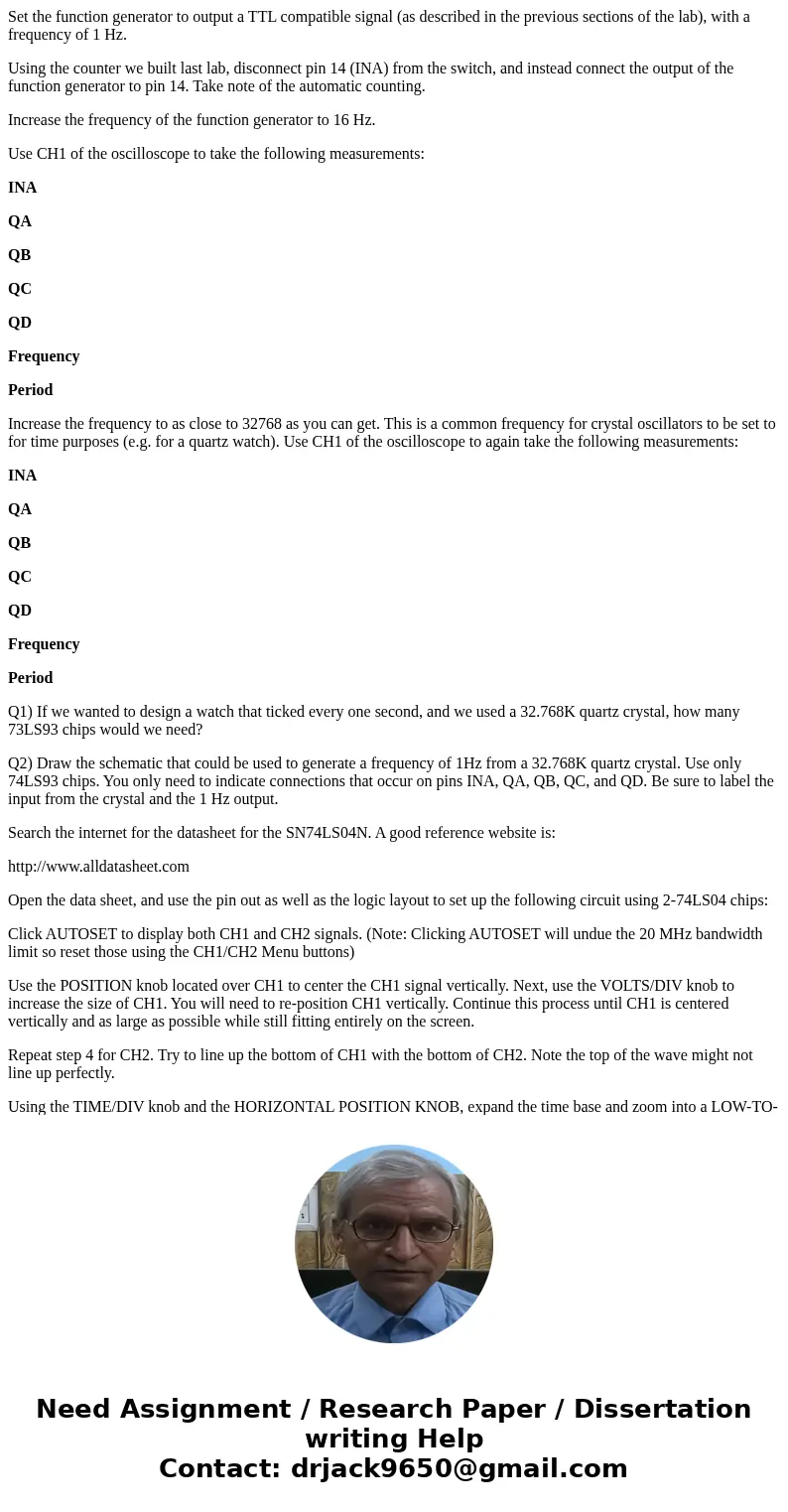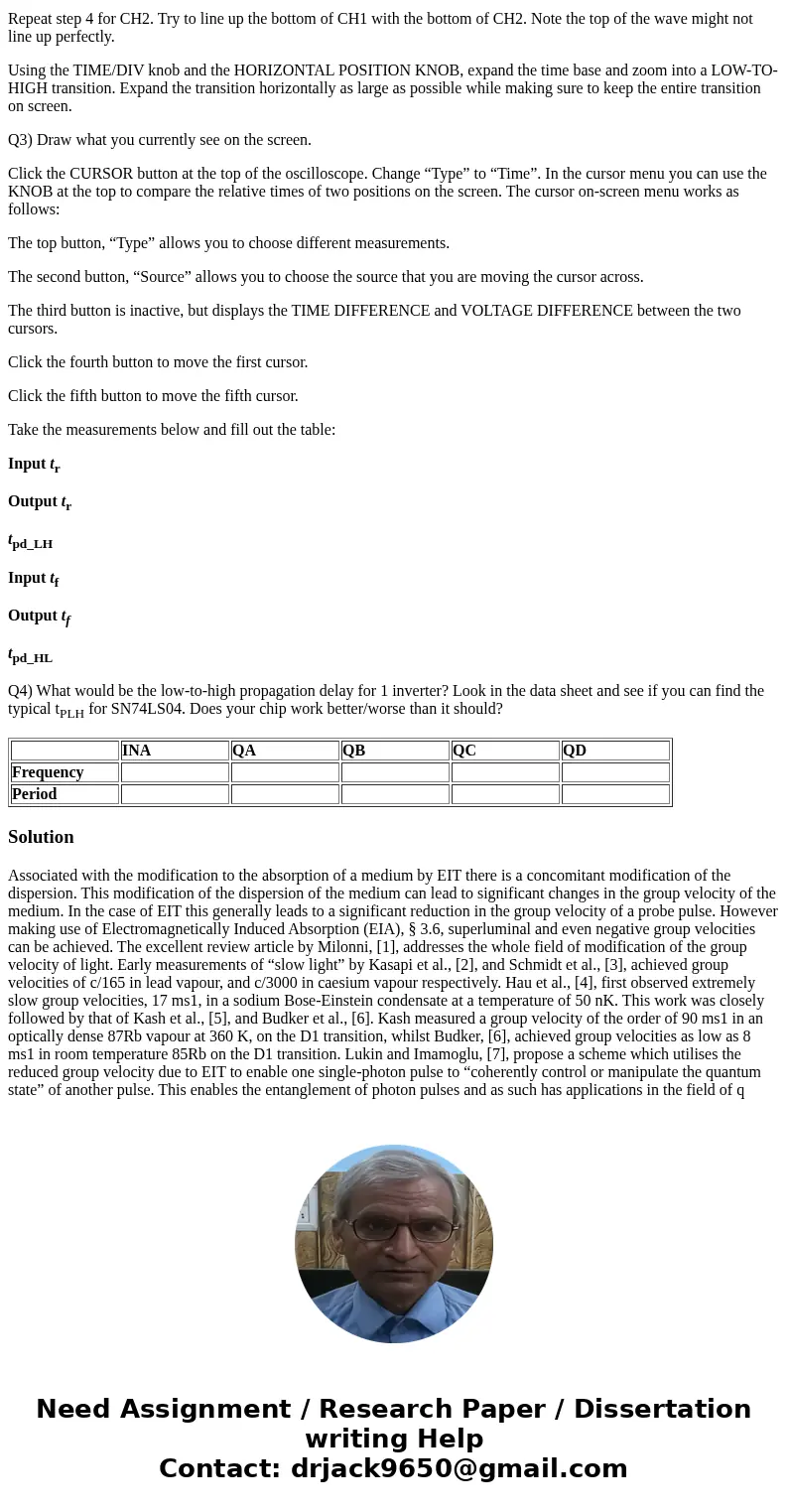Set the function generator to output a TTL compatible signal
Set the function generator to output a TTL compatible signal (as described in the previous sections of the lab), with a frequency of 1 Hz.
Using the counter we built last lab, disconnect pin 14 (INA) from the switch, and instead connect the output of the function generator to pin 14. Take note of the automatic counting.
Increase the frequency of the function generator to 16 Hz.
Use CH1 of the oscilloscope to take the following measurements:
INA
QA
QB
QC
QD
Frequency
Period
Increase the frequency to as close to 32768 as you can get. This is a common frequency for crystal oscillators to be set to for time purposes (e.g. for a quartz watch). Use CH1 of the oscilloscope to again take the following measurements:
INA
QA
QB
QC
QD
Frequency
Period
Q1) If we wanted to design a watch that ticked every one second, and we used a 32.768K quartz crystal, how many 73LS93 chips would we need?
Q2) Draw the schematic that could be used to generate a frequency of 1Hz from a 32.768K quartz crystal. Use only 74LS93 chips. You only need to indicate connections that occur on pins INA, QA, QB, QC, and QD. Be sure to label the input from the crystal and the 1 Hz output.
Search the internet for the datasheet for the SN74LS04N. A good reference website is:
http://www.alldatasheet.com
Open the data sheet, and use the pin out as well as the logic layout to set up the following circuit using 2-74LS04 chips:
Click AUTOSET to display both CH1 and CH2 signals. (Note: Clicking AUTOSET will undue the 20 MHz bandwidth limit so reset those using the CH1/CH2 Menu buttons)
Use the POSITION knob located over CH1 to center the CH1 signal vertically. Next, use the VOLTS/DIV knob to increase the size of CH1. You will need to re-position CH1 vertically. Continue this process until CH1 is centered vertically and as large as possible while still fitting entirely on the screen.
Repeat step 4 for CH2. Try to line up the bottom of CH1 with the bottom of CH2. Note the top of the wave might not line up perfectly.
Using the TIME/DIV knob and the HORIZONTAL POSITION KNOB, expand the time base and zoom into a LOW-TO-HIGH transition. Expand the transition horizontally as large as possible while making sure to keep the entire transition on screen.
Q3) Draw what you currently see on the screen.
Click the CURSOR button at the top of the oscilloscope. Change “Type” to “Time”. In the cursor menu you can use the KNOB at the top to compare the relative times of two positions on the screen. The cursor on-screen menu works as follows:
The top button, “Type” allows you to choose different measurements.
The second button, “Source” allows you to choose the source that you are moving the cursor across.
The third button is inactive, but displays the TIME DIFFERENCE and VOLTAGE DIFFERENCE between the two cursors.
Click the fourth button to move the first cursor.
Click the fifth button to move the fifth cursor.
Take the measurements below and fill out the table:
Input tr
Output tr
tpd_LH
Input tf
Output tf
tpd_HL
Q4) What would be the low-to-high propagation delay for 1 inverter? Look in the data sheet and see if you can find the typical tPLH for SN74LS04. Does your chip work better/worse than it should?
| INA | QA | QB | QC | QD | |
| Frequency | |||||
| Period |
Solution
Associated with the modification to the absorption of a medium by EIT there is a concomitant modification of the dispersion. This modification of the dispersion of the medium can lead to significant changes in the group velocity of the medium. In the case of EIT this generally leads to a significant reduction in the group velocity of a probe pulse. However making use of Electromagnetically Induced Absorption (EIA), § 3.6, superluminal and even negative group velocities can be achieved. The excellent review article by Milonni, [1], addresses the whole field of modification of the group velocity of light. Early measurements of “slow light” by Kasapi et al., [2], and Schmidt et al., [3], achieved group velocities of c/165 in lead vapour, and c/3000 in caesium vapour respectively. Hau et al., [4], first observed extremely slow group velocities, 17 ms1, in a sodium Bose-Einstein condensate at a temperature of 50 nK. This work was closely followed by that of Kash et al., [5], and Budker et al., [6]. Kash measured a group velocity of the order of 90 ms1 in an optically dense 87Rb vapour at 360 K, on the D1 transition, whilst Budker, [6], achieved group velocities as low as 8 ms1 in room temperature 85Rb on the D1 transition. Lukin and Imamoglu, [7], propose a scheme which utilises the reduced group velocity due to EIT to enable one single-photon pulse to “coherently control or manipulate the quantum state” of another pulse. This enables the entanglement of photon pulses and as such has applications in the field of q


 Homework Sourse
Homework Sourse